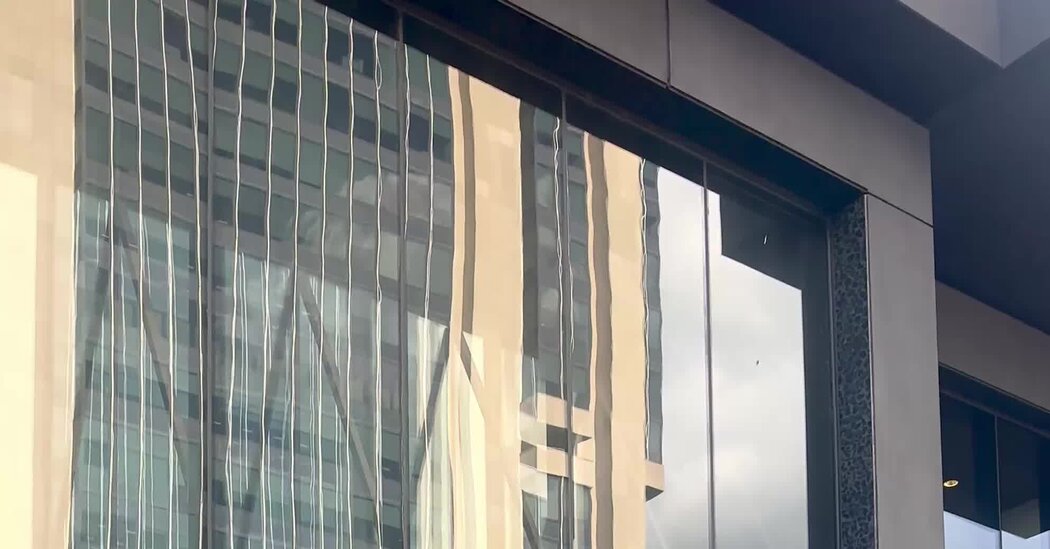The new Studio Museum in Harlem is unmissable on West 125th Street. Charcoal and gray, its jumbled facade of sculptured, stacked niches and window frames is poised like a Mondrian.
It faces off the towering, broad-shouldered Adam Clayton Powell Jr., State Office Building across the street, holding its own. Those grays and blacks, matte and polished, shift in the changing light.
The building is an architectural essay on varieties of blackness in precast concrete and polished aggregate.
Founded by a group of artists and philanthropists, the Studio Museum opened in 1968 in a loft over a liquor store. It moved during the early ’80s into a former bank it had been gifted that still had Depression-era wiring and no air conditioning.
J. Max Bond Jr., the esteemed Black architect and Harlem resident, performed miracles on a shoestring, retrofitting the bank’s interior. The museum put on groundbreaking shows. But like so many Black institutions in Harlem, it had no choice except to make do with its improvisatory architecture.
The new $160 million building is a different animal. It rises seven stories where the bank was demolished, doubling Studio’s exhibition space.
The museum now has custom-built classrooms for school groups; studios for resident artists; a library; a soaring, eye-popping lobby and monumental staircase that is the building’s circulatory and social spine; and also rooms where community organizations can meet.
From the roof garden, designed by Studio Zewde, a Harlem firm, the South Bronx is visible to the north past the famous YMCA tower on 135th Street. To the south, Midtown’s skinny supertalls preen over Harlem’s brownstones. Up there, the museum can feel like the center of the city.
Construction was delayed by the pandemic. The project took seven years. A scandal involving its brand-name lead architect, David Adjaye, caused him to absent himself, leaving the museum and the rest of its design team scrambling.
For its price tag and architectural ambition, it was an undertaking that only much wealthier institutions typically attempt. The Studio Museum had $10 million in reserves when the project started. Its endowment was zero.
A capital campaign by its director, Thelma Golden, an art world force-of-nature and famous figure in Harlem, raised $307 million, unheard-of for a small cultural organization. The extra money kept the Studio Museum’s operations and exhibition program afloat during those seven years, and also established a $23 million cash reserve and a $52 million endowment to insure that the lights stay on moving forward.
Now the building is finally opening Nov. 15. It’s a remarkable accomplishment and an uplifting, uncompromising addition to the city’s civic landscape.
It arrives on a 125th Street much changed from when the museum first moved there, with yet more churn on the way. The National Black Theater is moving into a new mixed-use, mixed-income tower it codeveloped on its former site. The Apollo Theater is undergoing a major renovation. It recently took over the Victoria Theater, next door, where a luxury hotel and affordable housing complex have risen.
And across the street from the Studio Museum, the Urban League Empowerment Center is a new office building with subsidized housing in the rear, a civil rights museum and a Trader Joe’s and Target on the street.
All that was unimaginable during the 1960s, when Harlem was hemorrhaging population and in free fall. Officials in Albany, promising Harlemites jobs, decided to demolish the whole north side of 125th Street between Seventh and Lenox Avenues, opposite where the Studio Museum is now, to make way for the state office building.
Protesters occupied the demolition site, demanding that Black residents, not upstate politicians and outsiders, determine what gets built on 125th Street. They erected a tent village with a field kitchen, health clinic and day care center, an early version of the pop-up encampments of the 2011 Occupy movement. The protesters renamed the demolition zone Reclamation Site No. 1.
Police forced the protesters to leave after several weeks. The 19-story state office building opened in 1974 on the corner where Malcolm X had delivered speeches outside Lewis Michaux’s National Memorial African Book Store.
But the eviction of the protesters wasn’t the end of the story. A coalition of local church leaders, bank presidents and other moderate community members in Harlem picked up where Reclamation Site No. 1 left off. They believed Black self-determination depended on financial autonomy. Future development on 125th Street would need to include office buildings, along with hotels, cultural tent poles and retail, to funnel wealth and other benefits to Black residents.
“Gentrification was never simply a process that happened to residents of Harlem,” as Brian Goldstein, an architectural historian of Harlem’s late-20th-century development, points out. “For decades gentrification has been a project of insiders.”
During the 1990s and 2000s it was led by the Abyssinian Baptist Development Corporation, the economic arm of the Rev. Calvin O. Butts III’s Abyssinian Baptist Church. The corporation built affordable and senior housing, schools, and developed the undistinguished but pivotal office tower by Hardy Holzman Pfeiffer that now houses a CVS and a Marshalls, on the lot where the tent village had stood.
What have these changes brought?
It’s complicated. There’s now a Wells Fargo where Lenox Lounge used to be. Harlemites can now shop at Trader Joe’s and at a Whole Foods up the block from the Studio Museum. Median rents in Central Harlem increased by 23 percent from 2006 to 2023, according to the N.Y.U. Furman Center. Gentrification has stirred a mix of opportunity and fear.
Darren Walker was chief operating officer for Abyssinian Development Corporation during the 1990s and early 2000s. Until recently he led the Ford Foundation, which last year awarded $10 million to endow Golden’s director’s position at the Studio Museum.
Its new building, he agrees, is part of a long transformation along 125th Street “rooted in Black culture and identity. Black cultural institutions were always told to make something out of nothing,” he says. “Ambitions were miniaturized. Make do was a metaphor for unworthiness.”
“The Studio Museum should now put a nail in that coffin.”
Adjaye Associates and Cooper Robertson, working with the structural engineer Guy Nordenson, are credited as architects for the project. Adjaye was the lead architect until an article in The Financial Times in 2023 reported on accusations by three unnamed women in his office of sexual harassment, assault and a “toxic work culture.”
He has denied the allegations. But clients cut ties and he retreated from projects that were far along, including the Studio Museum. He and Golden had worked closely on it for years.
Among those who stepped up are Pascale Sablan, from Adjaye Associates, and Erin Flynn at Cooper Robertson. Flynn served as executive architect at the Princeton Art Museum, as well, another stunning new Adjaye design, opening this weekend.
Ultimately, the building belongs to Harlem. The lobby becomes a de facto new indoor town square. All gray concrete, it can seem austere at a glance. I suspect it will quickly morph into a gathering spot once it’s packed with people and art.
It meets the sidewalk on 125th Street through glass doors, beckoning crowds to come in, climb the showpiece staircase and lounge on the bleacher seating that spills down like an indoor stoop to a cafe.
As with other Adjaye projects, the palette is restrained, the symbolism layered, the aesthetic severe, brawny, unapologetic. Marcel Breuer’s former Whitney Museum on Madison Avenue may come to mind. It’s where Golden cut her curatorial teeth. There, as here, material refinement and an undercurrent of warmth suffuse the Brutalist concrete.
In 1968, the Studio Museum opened with a show devoted to Tom Lloyd, then a little-known sculptor from Queens. Lloyd devised joyful, jury-rigged, blinking light sculptures using multicolored, rewired car amps. Abstraction was widely seen back then as white art. For Lloyd, Black art was whatever Black artists decided it would be. This would become the mantra of the museum.
Its new building opens, fittingly, with a Lloyd retrospective. It fills a double-height, barrel-vaulted room set apart from the museum’s more flexible, white box galleries. The barrel vault nods to Harlem’s religious sanctuaries, pillars of civic life and sources of inspiration in the neighborhood.
We’ll see what the room inspires in artists who will be invited to do special projects in the coming years.
I heard from Harlemites during the museum’s years of construction that Golden and her colleagues repeatedly went out of their way to keep neighbors abreast of progress, and sent out alerts whenever heavy equipment would close streets or sidewalks. “More often than not, organizations show up once at the community board,” one Harlemite told me.
It was a small point, but I passed the remarks on to Golden. She looked surprised.
“Why wouldn’t we tell people what’s happening?” she asked. “These are our neighbors.”
“I live here,” she said. “We live here.”
Michael Kimmelman is The Times’s architecture critic and the founder and editor-at-large of Headway, a team of journalists focused on large global challenges and paths to progress. He has reported from more than 40 countries and was previously chief art critic.
The post Harlem’s Remarkable New Studio Museum Redefines 125th Street appeared first on New York Times.




